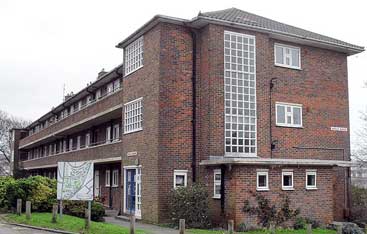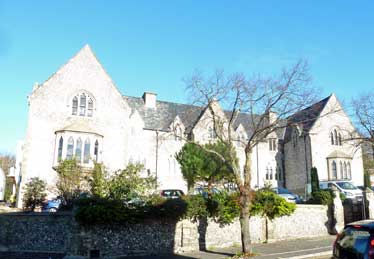The Round Hill Society
The home site of the Round Hill Society, a community group of the residents of Round Hill in Brighton, England. The site contains information about the area, latest news and reflections on life in Round Hill.
Sylvan Hall

Picture: Holly Bank (22 flats) on the Sylvan Hall Estate
Sylvan Hall Brighton today
South of Princes Crescent from junction of Belton Road to that of Crescent Road
The Poplars (6 flats)
The Willows (12 flats)
The Chestnuts (6 flats)
Access via Bromley Road off Ditchling Road
Birch Lodge (6 flats)
Firbank (6 flats
Hazelbank (12 flats)
Hollybank (22 flats)
Maple House (6 flats)
The Cedars (12 flats)
The Laurels
Larchbank (6 flats)
The Limes (6 flats)
Access via Canterbury Drive off Upper Lewes Road
Elm Lodge
Rowan House (9 flats)
The Lindens (12 flats)
The Pines
Holt Lodge
From the 1850s
Wakefield Villa later known as Woodfield Lodge and The Rookery was near the site now occupied by The Chestnuts.
Rosehill Villa (later known as Hill Lodge) was on the site now occupied by Birch Lodge and Holly Bank.
Rosehill Cottage, also known as The Cottage, was at the NE junction of Ditchling Road and Upper Lewes Road near the site now occupied by Rowan House.
Sylvan Lodge, known as Sylvan Hall from 1923, was on the site now occupied by Holt Lodge and The Pines.
Rose Hill Park and Round Hill Park villas
The Colbatch-Clark family bought the land in 1850, developing it as Round Hill Park. This also included the semi-detached villas that today are numbers 68 to 80 on the east side of Ditchling Road.
Rose Hill Park Villas (1871) [A] [B] [D] link to photos
For locations, see The side by side OS 25 inch 1892-1914 map
[A] WAKEFIELD VILLA Richard EDWARDS (born Hastings). Also known as WOODFIELD LODGE and THE ROOKERY. The 1878 Street Directory identifies 4 Wakefield Road (old street numbering: Sylvan Estate side of the street) as "Wakefield Villa". Demolished in 1951, the current blocks of 2 & 3 storey flats followed. See also Wakefield Road in 1871
[B] ROSEHILL VILLA Rev. Thomas MOSELY (born London) - listed under Ditchling Road (south of Bromley Rd). Also known as HILL LODGE. See article by Chris Tullett. Demolished in 1953.
[C] ROSE HILL COTTAGE John COLBATCH ONIONS (born Shrewsbury) listed under Ditchling Road (also called "THE COTTAGE"), a great deal larger than the name suggests, on the corner of Ditchling Road and Upper Lewes Road.
[D] SYLVAN LODGE George L. CLOWSER (born Middlesex) listed under 1 Upper Lewes Road. Demolished in the mid 1970s. Also known as SYLVAN HALL (from 1923) set back from the junction of Upper Lewes Road and Wakefield Road and located at the end of Canterbury Drive on a site now occupied by flats called The Pines.
Round Hill Park Villas (1871) - click on red links for more info
Semi-detached villas situated on Ditchling Road between Bromley Road and Princes Crescent
1 Round Hill Park Henry HOLLAMBY (Livery Stable Keeper)
2 Round Hill Park Edward WATERMAN (Attorney)
3 Round Hill Park Edward TAINSH (Author)
4 Round Hill Park James L.W.DIXON (Retired Surgeon)
5 Round Hill Park Thomas RUSCOE (No occupation)
6 Round Hill Park William WALKER (Railway Store Keeper)
7 Round Hill Park Amelia E. NEWMAN (Scholar)
8 Round Hill Park Sarah PATEY (No occupation: aged 60)
[These semi-detached villas on the east side of Ditchling Road are now numbered 68 to 80. See Side by side OS 25 inch 1892-1914 map]
From the 1900s
Rose Hill Cottage remained a home to the Clark family until 1939.
By 1903, Rosehill Villa (renamed Hill Lodge) was a dormitory for student teachers attending the Diocesan Training College (now Brighton Business Centre) at the NW junction of Ditchling Road and Viaduct Road.
By 1920 Sylvan Lodge was also accommodation for student teachers.
By 1931 student teachers also occupied Wakefield Villa, which was renamed "The Rookery".

DIOCESAN TRAINING COLLEGE Ditchling Rd & Viaduct Rd, built in 1854 and requisitioned by the government in 1939.
In 1939, funding was withdrawn from the Diocesan Council. The Brighton Diocesan Training College was one of three colleges selected for closure and was put up for auction. The building was requisitioned by the government and became the Pay Office for the Royal Engineers under the Ministry of Defence until 1987. The big houses were also rented out to the army.
Between 1945 and 1976
In 1945, the Colbatch-Clark family made a proposal for the whole estate to be developed as private apartments. A similar plan materialised, though the development was for Council housing.
The site of the four large villas was compulsorily purchased by Brighton Corporation in 1945 and from 1948 the current Sylvan Hall was developed.
Rosehill Villa (Hill Lodge) was demolished in 1948, Wakefield Lodge in 1951 and Sylvan Hall in the mid 1970s.
As these old houses were removed, blocks of two and three storey flats were erected, and the first of these were occupied early in 1951.
See The weblog of today's Sylvan Hall Residents' Association. The Estate as we see it today was completed in 1976.
This page was last updated by Ted on 03-Apr-2023